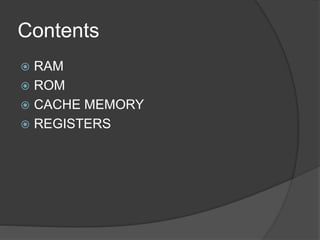
COMPUTER MEMORY
- 1. Contents RAM ROM CACHE MEMORY REGISTERS
- 2. Meaning of RAM. RAM or Random Access Memory also known as volatile memory is a form of computer data storage device which stores most commonly accessed data in the computer. It is a semi conductive memory module device made up of small memory chips installed on the motherboard of the computer.
- 3. Basic understanding on working of RAM Whenever you run a program (e.g. operating system, applications) or open a file (e.g. videos, images, music, documents), it is loaded temporarily from the hard drive into your RAM. Once loaded into RAM, you will be able to access it smoothly with minimal delays. The data are stored randomly on the RAM and it can be assessed directly. If you run out of RAM, your operating system will begin dumping some of the open programs and files to the paging file causing your computer to lag.
- 4. Basic understanding on how RAM works. HARD DRIVE USER RAM (Random Access Memory) CPU Data/Result inflow (less access time) Command to computer (less access time)
- 5. Typical RAM and its location in motherboard
- 6. Types Of RAM DRAM (Dynamic RAM) SRAM (Static RAM)
- 7. i. Dynamic RAM DRAM or dynamic random access memory is that type of RAM which stores data using a transistor and capacitor which are comprised together in a memory cell. The capacitor holds a high or low charge (1 or 0, respectively), and the transistor acts as a switch that lets the control circuitry on the chip read the capacitor's state of charge or change it. Since capacitors leak charge, the information stored in it fades unless the capacitor charge is refreshed periodically. It is smaller in size cheap but is slow compared to Static Ram.
- 8. ii. Static RAM Static random-access memory (SRAM) is a type of semiconductor memory that uses latching circuitry (flip flops) to store each bit. It does not need to be refreshed like DRAM and the data in it will only be deleted once the computer is shut down. It is more expensive type of RAM but is faster than DRAM. Because of its more parts it require more space than DRAM.
- 9. Importance Of RAM Load and run operating systems. Enable faster access to data.
- 10. Limitation of RAM Limited amount of data storage. Temporary Memory Expensive
- 12. Computer memory on which data has been prerecorded Data cannot be modified or with difficulty Enables an electronic device to regulate their motion Retains its content even when the computer is turned off. Device mainly used for storage
- 13. Programmable Read-only Memory(PROM) Erasable Programmable Read-only Memory(EPROM) Electrically Erasable Programmable Read- only Memory (EEPROM) Flash Memory
- 14. Data stored permanently Retains the content when the computer is turned off Manufactured as blank memory PROM programmer or a Prom burner
- 15. Enables a device to erase the data in ROM Exposed to ultra violent stored data deleted Enables to input new programme.
- 16. Data is erased electrically Requires data to be written or erased one byte at a time
- 17. Non –volatile computer storage medium Modified version of EEPROM Data can be erased & reprogrammed in blocks
- 18. Contents A brief introduction to Cache memory Types of Cache memory Where is Cache located Advantages and Disadvantages Process Flow
- 19. CACHE MEMORY A BRIEF INTRODUCTION TO CACHE MEMORY What is cache (pronounced as cash)memory ?? →high-speed access area (either a reserved section of main memory or a storage device.) →high speed buffer made up of SRAM (static RAM) that stores the most frequently accessed data and instructions for quick retrieval. →Intermediate between CPU and main memory(access time of cache memory is very small than that of main memory →much faster than RAM or main memory →more expensive.
- 20. TYPES OF CACHE MEMORY ❶Memory cache(portion on memory of high- speed SRAM) ❷Disk cache(used to access commonly accessed data) ❸Internet browser cache(used to help improve how fast data is opened while browsing the Internet.)
- 21. WHERE IS CACHE LOCATED ? ○Level 1 - in the processor ○Level 2 - dedicated for the processor but not in the processing logic ○Level 3 - shared between processors
- 22. ADVANTAGES AND DISADVANTAGES Advantages Reduce load on Web Services/ Database Increase Performance Reliability (Assuming db backed cache. Server goes down and db is backed by cache. There is no time wasted to repopulate as in memory cache) Disadvantages Could run into issues syncing caches Increased Maintenance Scalability Issues
- 24. PROCESS FLOW
- 25. -
- 26. Contents Introduction to registers Functioning of registers Registers perform Types of registers Working of a memory device
- 27. REGISTERS • Very small amount of very fast memory built into the CPU to speed up its operations by providing quick access to commonly used values, • The fastest way for the system to manipulate data, • Mostly implemented as an array of SRAM (Static Random Access Memory), • Normally measured by the number of bits they can hold
- 28. Functioning of REGISTERS Used by the CPU for performing the operations. Step1: User gives some input to the system. Step2: Input is stored into the registers. Step3: CPU processes the data. Step4: Result is stored in the registers. Step5: System gives the result to the users.
- 30. Types of Registers Memory Address Registers Program Counter Accumulator Register Memory Data Register Index Register Memory Buffer Register Data Register
- 31. How do the memory devices work?
- 32. THANK YOU FOR YOUR ATTENTION.